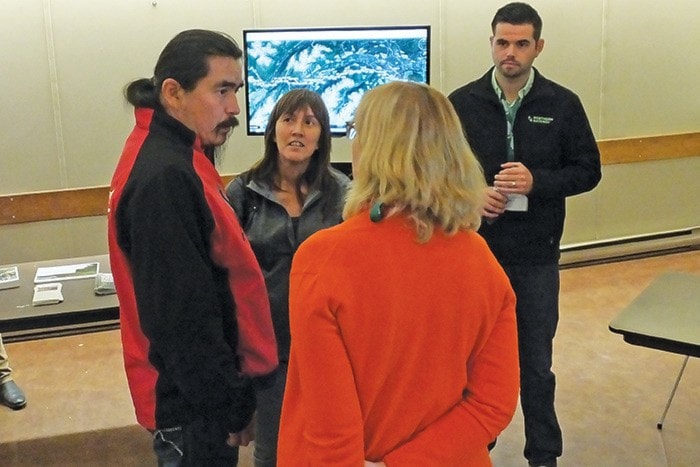The first information session on Enbridge’s proposed Northern Gateway Pipeline project was held Sept. 30 in Houston.
The “Let’s Talk” open house was one of 10 held in B.C. and Alberta communities along the proposed route that would bring bitumen oil west to be shipped overseas from Kitimat in one pipe. A second pipe would send the required chemicals to move that bitumen back east to the Bruderheim pump station north of Edmonton.
“Houston’s an important part of our project of course, our pipelines will run just south of Houston and we’ve actually got a pump station that will be located just south of Houston,” said Donny van Dyk, Northern Gateway coastal aboriginal and community relations manager, at the open house.
Other communities visited in B.C. this month include Burns Lake and Fort St. James, where there are also planned pump stations, Fraser Lake, Prince George, Terrace, and Kitimat, which is the last stop in B.C. for phase one meetings Thursday. Northern Gateway has three engagement phases: phase two starts in March, and three is scheduled for late next year or early 2016.
“This go-around we are in communities that are as close and affected by our project as we can be,” said van Dyk when asked why there was no meeting planned in Smithers, which is nearly the same distance north from the proposed route as Prince George is south.
“It doesn’t preclude us from being active in Smithers. We were in Telkwa for a presentation to council earlier in the year... and we will I’m sure be back in Smithers and Telkwa, but for this particular trip we tried to focus at this juncture on the communities that were closest and most affected by our project,” explained van Dyk.
The community consultations had industry experts in a variety of areas to answer questions. The engagement by Enbridge is part of the approval conditions set out by the National Energy Board’s Joint Review Panel and agreed to by the federal government in June.
Tables with bitumen samples, interactive maps, and a sample piece of pipe made from the same materials planned for use in the $6.5 billion, 1,177-kilometre-long project were spread inside the Houston Community Hall.
Phase one condition plans covered by the displays, information packages, and USB sticks handed out are available online at Enbridge’s gatewayfacts.ca.
They include the traditional land use investigation, pipeline environmental effects monitoring, marine environmental effects monitoring, marine mammal and construction marine mammal protection, construction environmental protection and management, wetlands functional assessment, and socio-economic effects monitoring.
Opposition to the project from area First Nations is fierce. Freda Huson of the Wet’suwet’en First Nation’s Unist’ot’en Clan and Toghestiy of the Likhts’amisyu Clan were at the Houston open house. They have set up a blockade south of Houston on Morris West Road near the proposed Northern Gateway route, which was moved more south from the permanent camp set up.
The two said a trespass notice in the form of a feather was given to director of aboriginal and community engagement Michele Perret, who was at the hall.
“They say for 10 years they’ve been engaging with aboriginal groups, which I say is a lie because we told them seven years ago no to their project; so they’re skirting around us and still trying to proceed with their project,” said Huson.
The clans have been camped out at the blockade full time for two years after setting up the blockade initially five years ago. Huson and Toghestiy said they are against any pipeline coming through the territory.
“Protect it for future generations; protect it for the salmon because that’s where the salmon spawn then go into the Bulkley and Skeena. They’re already at a threat because of global warming and the environmental impacts. These projects would speed track global warming and will impact everybody on this planet, not just us,” said Huson, adding she is disappointed in what she describes as the watering down of federal environment regulations.
Toghestiy pointed to the toxins affecting Alberta First Nations near the oilsands and Enbridge’s track record with spills like the one in Michigan’s Talmadge Creek which feeds into Kalamazoo River in 2010 as causes for concern.
He also does not see hydro dam development as the answer.
“Alternative energies like solar, wind, water (on a smaller scale),” said Toghestiy.
“It has to be sustainable, not just boom and bust projects like this that come and go and the only people that are going to benefit are the companies, not our people,” said Huson, adding that she sees most of the jobs from the project being temporary.
Enbridge aims to complete the three-year construction of Northern Gateway in 2019.
“Our plan was to have construction commence Q4, 2015; however, as these conditions are taking more time to meet as we’re taking more time on consultation and meeting conditions, we will no longer be ready for Q4 2015 construction and are now looking at a 2016 construction start at the earliest,” said van Dyk.
“Each one of these stations is manned by an expert in the field with a working draft plan that they’re able to share information on and, more importantly, collect information back from citizens so that it can be incorporated into the final plan that will eventually be submitted to the National Energy Board,” said van Dyk.
